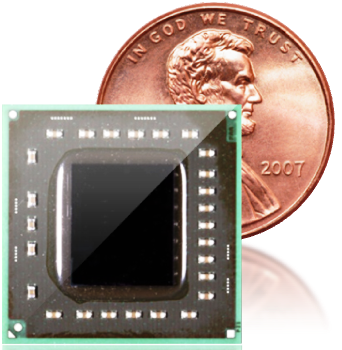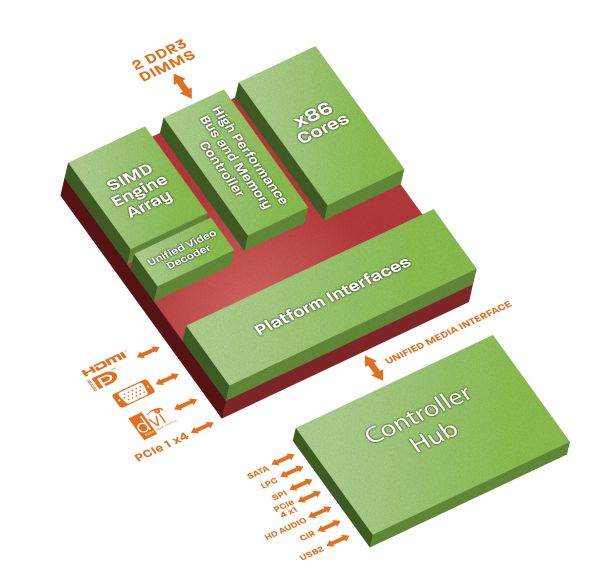AMD G-Series Brings APUs to the x86 Embedded Market
by Ganesh T S on January 19, 2011 12:29 AM ESTThe embedded market is huge and growing, and needs innovative, complete system platforms. These systems are compute intensive and have high performance graphics requirements, which make the embedded market a key part of AMD's strategy to drive revenue growth. There is an ongoing push for decreased power, smaller size and higher capability systems at lower price points. The strong visual element and growing need for quality graphics in many embedded markets such as set top boxes make it the ideal time for the AMD APU to get introduced into this space.

AMD's solutions (integrated CPU + GPU) are ideal for thin clients, medical imaging, point of sale and kiosk systems, gaming machines, digital signage and single board computing systems. These APUs integrate a multi-core CPU and a GPU sub-system on the same die to give a general-purpose, programmable scalar and vector processor core with heterogeneous capabilities.
The AMD Embedded G-Series Platform consists of an APU and a Fusion Controller Hub. The features are as below:
APU
- 2 x86 CPU Cores (40nm “Bobcat” core – 1 MB L2, 64-bit FPU)
- C6 and power gating
- Array of SIMD Engines [ DX11 graphics performance, Industry leading 3D and graphics processing ]
- 3rd Generation Unified Video Decoder [ H.264, VC1, DivX/Xvid ]
- DDR3 800-1066, 2 DIMMs, 64 bit channel
- BGA package
AMD Fusion Controller Hub for display and I/O
- Two dedicated digital display interfaces [ Configurable externally as HDMI, DVI, and/or Display Port, and as single link LVDS for internal panels ]
- Integrated VGA
- 5x8 PCIe®
- “Hudson” Fusion Controller Hub
With the introduction of the G-Series, AMD is showing a strong commitment to the x86 embedded market. AMD claims that it is the world's first and only APU for embedded systems. AMD Fusion can bring a new generation of differentiated, small form factor embedded systems that consume less power, yet deliver improved performance and features. The GPU component can deliver an outstanding visual experience compared to other x86 based embedded systems.
We are reproducing the different SKUs available for the APU as well as the platform controller hub (PCH) from AMD's official site below (click to enlarge):
Given ATI's strong GPU background, there is no doubt that the graphics in the G-Series will turn out to be much better than the embedded solution from Intel and VIA. However, we do have some concerns about the capability of the UVD engine in the platform. While the marketing slides indicated that Blu-Ray titles can be smoothly played back, it also had another entry indicating that 1080p video playback support availability was only in the 18W processors and higher. We were also not provided with the difference between the embedded G-Series and the desktop Brazos platform that Anand had covered earlier. It looks likely that the GPU capabilities (SIMD engine) are not the same, with the embedded solution having half the number of stream processors. However, we are awaiting confirmation on this. Expect an update in this section as soon as we hear back from AMD.













76 Comments
View All Comments
pinki - Wednesday, January 19, 2011 - link
omg go AMDSkribbel - Wednesday, January 19, 2011 - link
Congrats on the first post and yes, I agree, AMD is bringing some interesting new tech to the embedded market table. Intel's Atom is in dire need of competition in all of its market segments to encourage less blissfully stagnant development.This: "AMD is putting up this solution against the Embedded Atom series models from Intel, promising better footprint (lesser number of balls to route)."
I like the idea of a better footprint, but if AMD is going to complete, they need to have as many balls as possible! More balls are better, I say!
MeanBruce - Wednesday, January 19, 2011 - link
Tell him what he's won Bob!First poster should receive a $20 gift card/code from Newegg! ;)
Brunnis - Wednesday, January 19, 2011 - link
This article reads like a commercial. Not what I've come to expect from Anandtech.Also, isn't "APU" a marketing word for AMD's Fusion? In light of that, the way the article uses the word also adds to the feeling of it being more of a commercial than anything else.
ganeshts - Wednesday, January 19, 2011 - link
It is always good to listen to user feedback. After all, AnandTech can't be where it is right now without its readers.That said, I am sure AMD's 'commercial' wouldn't contain stuff like:
I believe I have presented a balanced view of today's announcement.
Brunnis - Wednesday, January 19, 2011 - link
Not all of it sounds like a commercial, but paragraphs like these don't really belong outside of a company press release:"The APUs are ideal solutions for thin clients, medical imaging, point of sale and kiosk systems, gaming machines, digital signage and single board computing systems. They integrate a multi-core CPU and a GPU sub-system on the same die to give a general-purpose, programmable scalar and vector processor core with heterogeneous capabilities."
"AMD is showing a strong commitment to the x86 embedded market. The G-Series platform is the world’s first and only APU for embedded systems. Cutting-edge AMD Fusion technology brings a premier solution for a new generation of differentiated, small form factor embedded systems that consume less power, yet deliver improved performance and features, including an outstanding visual experience compared to other x86 based embedded systems."
ganeshts - Wednesday, January 19, 2011 - link
Thanks for pointing out the 'offending' content. Let me edit it to convey the points succintly.FATCamaro - Wednesday, January 19, 2011 - link
I absolutely agree with Brunnis.Those two paragraphs he indicates sound like a press release, AND are somewhat in contradiction to your own criticisms of the parts above.vol7ron - Wednesday, January 19, 2011 - link
I don't agree absolutely :)I like a little extra information in the read, I like having some background as to possible systems in mind. And I think I could learn to live with phrases like "ideal solutions" and "cutting-edge", even though they might be emotionally driven.
Keep in mind the share price keeps falling and AMD may not exist too much longer - that's not a good thing for anyone. Competition is a requirement.
HibyPrime1 - Wednesday, January 19, 2011 - link
I gotta agree with vol7ron here.I read the spreadsheet first before the article, and was thinking to myself, what exactly are they targeting here? Too much power for ultra-low power systems (microwaves, phones, routers), and they already have a line in place for netbooks/tablets.
Reading the first 'offending' paragraph put in perspective what they were shooting for. The second paragraph was a little less helpful, but AMD does need all the help it can get here.